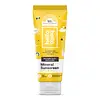What's inside
What's inside
 Key Ingredients
Key Ingredients

 Benefits
Benefits

 Concerns
Concerns

 Ingredients Side-by-side
Ingredients Side-by-side

Zinc Oxide 20%
Cosmetic ColorantArachidyl Alcohol
EmollientArachidyl Glucoside
EmulsifyingBehenyl Alcohol
EmollientBisabolol
MaskingButyloctyl Salicylate
Skin ConditioningButyrospermum Parkii Butter
Skin ConditioningCalendula Officinalis Flower Extract
MaskingCamellia Sinensis Leaf Extract
AntimicrobialCaprylhydroxamic Acid
Capryloyl Glycerin/Sebacic Acid Copolymer
Skin ConditioningCaprylyl Glycol
EmollientCellulose Gum
Emulsion StabilisingCetearyl Alcohol
EmollientCetyl Alcohol
EmollientChamomilla Recutita Flower Extract
MaskingCitric Acid
BufferingCitrus Aurantium Dulcis Peel Oil
MaskingCoco-Glucoside
CleansingCocos Nucifera Oil
MaskingCucumis Sativus Fruit Extract
EmollientDiheptyl Succinate
EmollientGlycerin
HumectantMethyl Dihydroabietate
Microcrystalline Cellulose
AbsorbentPolyhydroxystearic Acid
EmulsifyingPersea Gratissima Fruit Extract
EmollientPrunus Armeniaca Kernel Oil
MaskingSodium Gluconate
Skin ConditioningSodium Hyaluronate
HumectantSodium Stearoyl Glutamate
CleansingTheobroma Cacao Seed Butter
EmollientTocopherol
AntioxidantTriethyl Citrate
MaskingVanilla Planifolia Fruit Extract
Skin ConditioningWater
Skin ConditioningZinc Oxide 20%, Arachidyl Alcohol, Arachidyl Glucoside, Behenyl Alcohol, Bisabolol, Butyloctyl Salicylate, Butyrospermum Parkii Butter, Calendula Officinalis Flower Extract, Camellia Sinensis Leaf Extract, Caprylhydroxamic Acid, Capryloyl Glycerin/Sebacic Acid Copolymer, Caprylyl Glycol, Cellulose Gum, Cetearyl Alcohol, Cetyl Alcohol, Chamomilla Recutita Flower Extract, Citric Acid, Citrus Aurantium Dulcis Peel Oil, Coco-Glucoside, Cocos Nucifera Oil, Cucumis Sativus Fruit Extract, Diheptyl Succinate, Glycerin, Methyl Dihydroabietate, Microcrystalline Cellulose, Polyhydroxystearic Acid, Persea Gratissima Fruit Extract, Prunus Armeniaca Kernel Oil, Sodium Gluconate, Sodium Hyaluronate, Sodium Stearoyl Glutamate, Theobroma Cacao Seed Butter, Tocopherol, Triethyl Citrate, Vanilla Planifolia Fruit Extract, Water
Butyl Methoxydibenzoylmethane 3%
UV AbsorberHomosalate 10%
Skin ConditioningEthylhexyl Salicylate 5%
UV AbsorberOctocrylene 8%
UV AbsorberWater
Skin ConditioningBeeswax
Emulsion StabilisingAloe Barbadensis Leaf Juice
Skin ConditioningIsopropyl Palmitate
EmollientCetearyl Alcohol
EmollientCyclopentasiloxane
EmollientCyclohexasiloxane
EmollientCeteareth-20
CleansingHydroxyacetophenone
AntioxidantCarbomer
Emulsion StabilisingBenzyl Alcohol
PerfumingSaccharide Isomerate
HumectantPhenoxyethanol
PreservativeSodium Stearoyl Glutamate
CleansingTriethanolamine
BufferingTocopheryl Acetate
AntioxidantSodium Chloride
MaskingCitric Acid
BufferingButyl Methoxydibenzoylmethane 3%, Homosalate 10%, Ethylhexyl Salicylate 5%, Octocrylene 8%, Water, Beeswax, Aloe Barbadensis Leaf Juice, Isopropyl Palmitate, Cetearyl Alcohol, Cyclopentasiloxane, Cyclohexasiloxane, Ceteareth-20, Hydroxyacetophenone, Carbomer, Benzyl Alcohol, Saccharide Isomerate, Phenoxyethanol, Sodium Stearoyl Glutamate, Triethanolamine, Tocopheryl Acetate, Sodium Chloride, Citric Acid
 Reviews
Reviews

Ingredients Explained
These ingredients are found in both products.
Ingredients higher up in an ingredient list are typically present in a larger amount.
Cetearyl alcohol is a mixture of two fatty alcohols: cetyl alcohol and stearyl alcohol. It is mainly used as an emulsifier. Emulsifiers help prevent the separation of oils and products. Due to its composition, it can also be used to thicken a product or help create foam.
Cetearyl alcohol is an emollient. Emollients help soothe and hydrate the skin by trapping moisture.
Studies show Cetearyl alcohol is non-toxic and non-irritating. The FDA allows products labeled "alcohol-free" to have fatty alcohols.
This ingredient is usually derived from plant oils such as palm, vegetable, or coconut oils. There is debate on whether this ingredient will cause acne.
Due to the fatty acid base, this ingredient may not be Malassezia folliculitis safe.
Learn more about Cetearyl AlcoholCitric Acid is an alpha hydroxy acid (AHA) naturally found in citrus fruits like oranges, lemons, and limes.
Like other AHAs, citric acid can exfoliate skin by breaking down the bonds that hold dead skin cells together. This helps reveal smoother and brighter skin underneath.
However, this exfoliating effect only happens at high concentrations (20%) which can be hard to find in cosmetic products.
Due to this, citric acid is usually included in small amounts as a pH adjuster. This helps keep products slightly more acidic and compatible with skin's natural pH.
In skincare formulas, citric acid can:
While it can provide some skin benefits, research shows lactic acid and glycolic acid are generally more effective and less irritating exfoliants.
Most citric acid used in skincare today is made by fermenting sugars (usually from molasses). This synthetic version is identical to the natural citrus form but easier to stabilize and use in formulations.
Read more about some other popular AHA's here:
Learn more about Citric AcidSodium Stearoyl Glutamate is an emulsifier and helps condition the skin. It is amino acid-based.
In higher amounts, it may act as a cleansing agent.
Water. It's the most common cosmetic ingredient of all. You'll usually see it at the top of ingredient lists, meaning that it makes up the largest part of the product.
So why is it so popular? Water most often acts as a solvent - this means that it helps dissolve other ingredients into the formulation.
You'll also recognize water as that liquid we all need to stay alive. If you see this, drink a glass of water. Stay hydrated!
Learn more about Water